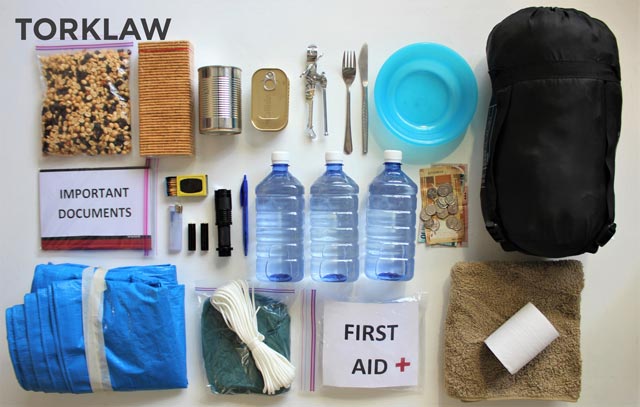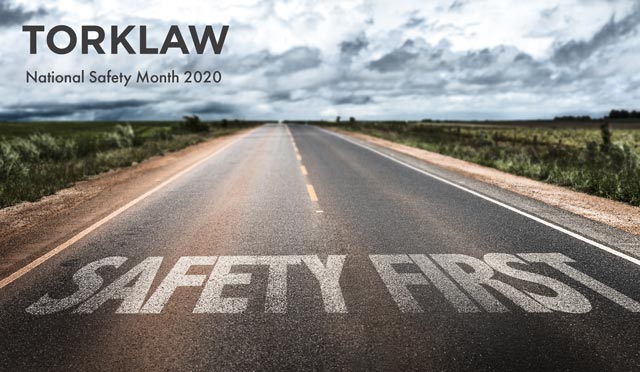Together with the National Safety Council (NSC), TorkLaw wants to eliminate preventable injuries and deaths at home, at work, and in our communities by observing National Safety Month 2020. The NSC celebrates National Safety Month each June to help people recognize the hazards around them, so we can all do our best to avoid them.
For National Safety Month last year, we focused on:
In the past few months, we have all been so consumed by the risk of COVID-19, we may not be noticing other hazards. So for National Safety Month 2020, we focus on these four topics:
National Safety Month 2020 Week 1 – Emergency Preparedness

June 1-7: There are many types of emergencies that can drastically change our circumstances and daily lives. Are you prepared for them?
Evacuation due to a fire, flood, earthquake or other natural disaster – In situations like these, we may be required to leave our homes and take shelter someplace else. Or, we may be able to stay in our homes, but without access to electric power, natural gas or fresh water.
Do you have a plan and supplies in place to respond quickly to this type of event? For example, a “go bag” with 1-2 changes of clothes and necessary toiletries; a one-week’s supply of fresh water for each person in your house; a supply of non-perishable food such as canned goods, crackers, nutrition bars, etc.
Shelter in place emergencies, such as the COVID-19 pandemic. During the coronavirus pandemic, government-mandated stay-at-home orders caused many people to panic. If you’re able to do so, try to keep an adequate supply of food, toilet paper, and other necessities on hand, so that you won’t need to panic.
Medical emergencies: When someone is injured, a fast response can be the difference between life and death. For most medical emergencies, the best response is to call 911 and follow the operator’s instructions. Knowing how to perform basic first aid and CPR can help you keep the injured person alive until the first responders arrive. The American Red Cross offers affordable online training courses, as well as local live courses.
Responding to violence: If you witness or are confronted by a person who is behaving in a dangerous, violent or threatening manner, try to remove yourself from the situation if you can do so safely. DO NOT try to confront an aggressive or potentially violent person. Stay calm and call 911 if you or others are in danger – but only if and when it is safe to do so.
National Safety Month 2020 Week 2 – Safe Driving
June 8-14: Did you know that someone in the United States is injured in a car accident every 7 seconds, and every 15 minutes, someone in the U.S. dies as the result of a car crash?
The largest cause of these accidents is driver error. Avoid these reckless driving behaviors:
- Speeding: Don’t exceed the speed limit, or the speed that is safe given the conditions. For instance, you should drive more slowly in the rain or snow, because slippery road conditions may increase your stopping distance.
- Tailgating, or following the car in front of you too closely. This causes the majority of rear-end collisions.
- Disrupting the flow of traffic: This includes driving too slowly and weaving in and out of lanes.
- Drunk driving or drugged driving: It’s not worth it to drive while impaired. Don’t drink and drive, or drive after taking any sort of drug – including marijuana. Call a ride service instead.
- Distracted driving: We all know the dangers of texting while driving – but that’s not the only distraction that can cause accidents. Eating, dealing with a pet in the car, having a hands-free conversation or even daydreaming are common driver distractions. Avoid anything that takes your eyes off on the road.
- Drowsy driving: Driving while fatigued is as dangerous as driving drunk. Avoid drowsy driving crashes by getting enough rest before you get behind the wheel.

National Safety Month 2020 Week 3 – Ergonomics
June 15-21: At TorkLaw, we see many clients who have suffered catastrophic workplace injuries, such as cell tower or construction site injuries. But even if you work behind a desk, you are not necessarily safe from an injury that can impair your ability to work. A workstation that is not set up properly can lead to overexertion and injury.
This is especially important if you work from home, where you may not have a conventional workspace.
Listen to your body and to set up your workstation ergonomically and reduce your chance of workplace injury.
- Maintain a neutral posture and position: one that doesn’t involve awkward positioning of your arms, hands, legs or back.
- Keep your work close to your body to minimize reaching or unsafe lifting practices.
- Take frequent breaks to stretch, change your position and/or walk around.
- Use all available tools and resources to reduce force and repetitive movement.
- Minimize contact with surfaces that apply pressure to parts of your body, or expose it to continuous vibration.
- Ensure you have adequate lighting – bright enough to see clearly while avoiding glare

Week 4 – Employee Engagement/Workplace Safety
June 22-30: At work, safety is everyone’s job. Don’t assume the management knows about unsafe conditions or that they will automatically provide you with the safety or ergonomic equipment you need.
If you see something that seems unsafe to you, say something to your manager, human resources, or safety coordinator, if you have one. If you feel you need ergonomic equipment like a footrest or back brace, make the request. If your employer doesn’t give you the time or freedom to stretch and change position, they might be violating the law.
If you are injured on the job because your employer violated Occupational Safety and Health Administration standards, you may not be limited to workers’ compensation alone. Contact TorkLaw to find out your options.
And share this article to spread the word about National Safety Month 2020, and keep your family and friends safe throughout the year.
Did you find this post informative? You may also want to check out the below content:
April is Distracted Driving Awareness Month
Is Daylight Saving Time Dangerous? Here’s What the Studies Say



